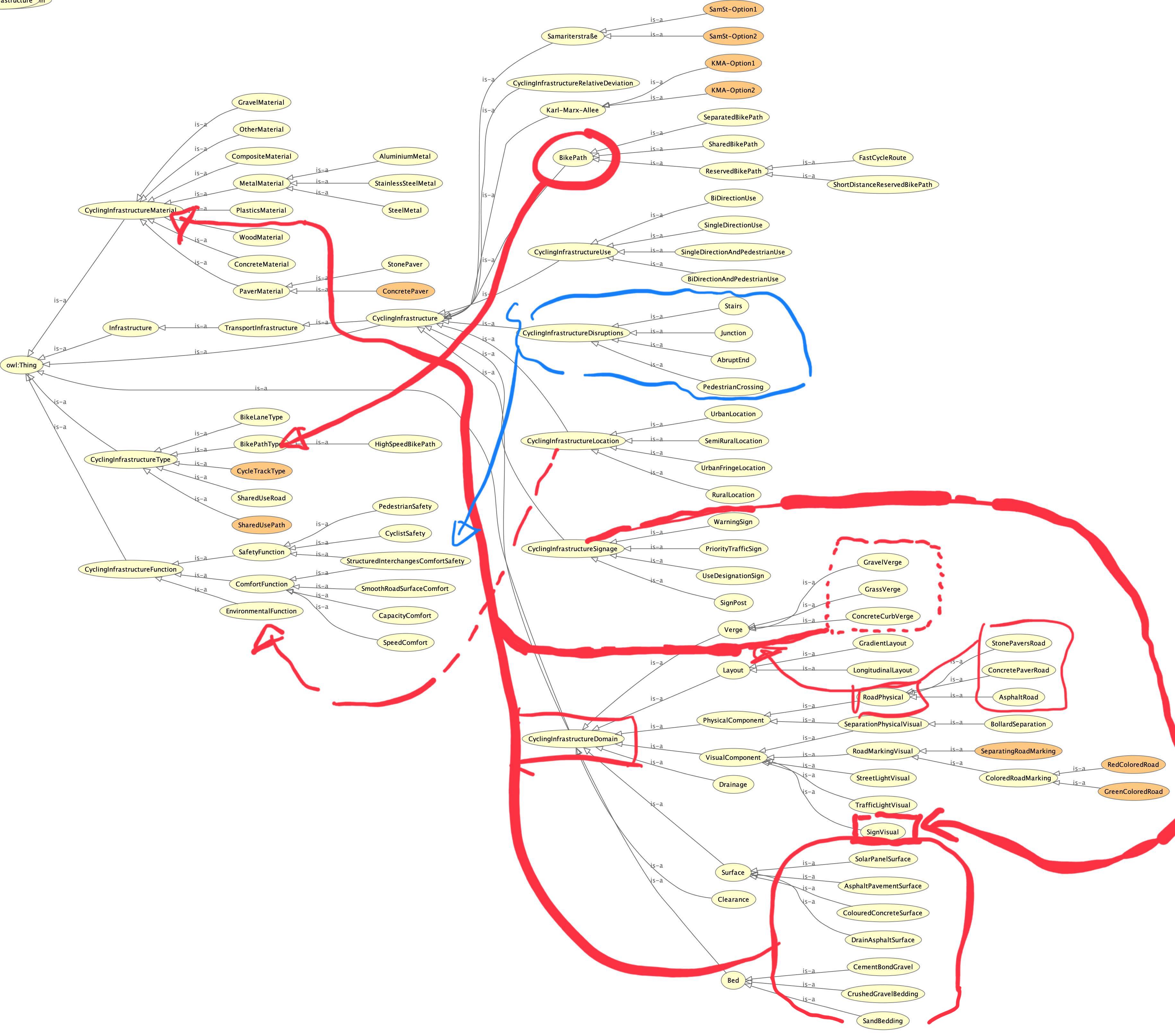During the first part of a cognitive process, four different and completely distinct ontologies have been created, each treating of a concept and a category in the area of construction engineering that comprise their relations among each other and further properties. The task was to create an all-encompassing ontology for all engineering products. This work will contain the merger of ontologies, the change of classes, subclasses and properties and the creation of new content for the ontologies, to make them fit into one.
The four ontologies (Bike Infrastructure, Tunnel, Bike Bridge and High-speed Bikeway) were first structured by their compatibility. The High-Speed Bikeway and the Bike infrastructure were chosen as the main ontologies; when merged, both the tunnel and the bike bridge ontologies should fit perfectly within these.
First, similar classes such as the Cycling “Infrastructure Domain”, that both ontologies contain, were moved into one class. Almost every subclass thereof was aligned next to each other with the exception of the subclass “Sign Visual”. At the current state, a visual sign would not fit into this class. The High-speed Bikeway domain contained the class “Cycling infrastructure Signage” within which it was easy to place the “Sign Visual” class. Next, the classes “Bike Path type” and “Bike path” were aligned and merged to create a new all-encompassing class for types of bikes paths such as separated, shared high speed and/or reserved bike paths.
The class “Structured Interchanges Comfort Safety” of the Cycling infrastructure ontology was categorized as a function within this ontology. Adding to this in the new merged ontology between the Cycling infrastructure and the High-speed-Bikeway, the class “Cycling Infrastructure Disruptions” has been merged into the prior class. The intention of doing so was that the disruptions are highly connected with safety issues and as such, should be connected in the new ontology.
Classes that have almost the same content such as “Materials” and “Use” have been aligned spanning over all four ontologies.
After having successfully merged the two ontologies of the bicycle infrastructure and the highspeed bikeway above, the next step was to integrate the tunnel and the bridge ontology within the existing one.
Both, the tunnel and the bridge ontology were aligned, from a structural point of view, in how they were built. This helped immensly during the process of merging. First, the tunnel ontology was studyied in depth. All superclasses have been newly arranged and made subclasses of the “Tunnel” class, while the “Tunnel” class is now a subclass of the all comprising superclass “Infrastructure”. “Tunnel Domain” can now be found within the “Tunnel” class. The idea behind this is that the whole ontology descriebes an infrastructure project of which a possible manifestation is a tunnel (or a bridge as we will see later). For the sake of creating an ontology that serves the purpose of bicycle infrastructure, the class “Tunnel Main Usage” has been deleted. The classes within described other uses of a tunnel, such as a flood protection use. The only subclass that is exempt from this is the “TransportationUse” subclass, which has been renamed and merged with the “Users” class. Of course, all of these possible uses could have been directly linked to the infrastructure class and made a sibling thereof, but the goal was to keep the whole ontology as simple as possible while at the same time encompassing all relevant information. The class “TunnelMainMaterial” has been merged into the “CyclingInfrastructureMaterial” class, as the tunnel is defined as a cycling infrastructure in this ontology.
Having integrated the tunnel ontology with both the bicycle infrastructure and the highspeed bikeway ontologies, the last step was to merge the bike bridge ontology. As stated above, the general structure of both the tunnel and bike bridge ontologiy has been relatively equal. As such, the class “Materials” has been merged into the “CyclingInfrastructureMaterial” class as well. Of course, duplicated classes have been deleted. Also, the class “Structural Level” has been merged into the “Bikes Bridge” class. As a subclass thereof, it is clearly shown that the structure of the bridge only serves the purpose of being a bikes bridge. The same has been done with the tunnel ontology above. Finally, the class “users” has been made a sibling class of the classes “Tunnel”, “Bikes Bridge”, and “Transportation Infrastructure”. This class is not to be confused with “CyclingInfrastructureUse”. This class describes if the cycling infrastructure is used on or two ways and if its osed by both, pedestrians and bikes or only by bikes.
Having created an all-encompassing ontology for a bike infrastructure engineering project, in the next step the parametric design will take place to visualise each engineering product in a better way.

